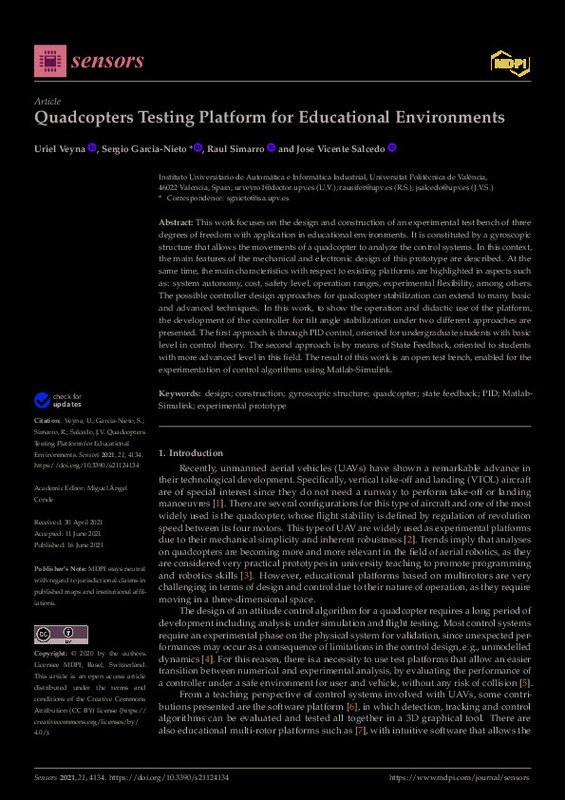JavaScript is disabled for your browser. Some features of this site may not work without it.
Buscar en RiuNet
Listar
Mi cuenta
Estadísticas
Ayuda RiuNet
Admin. UPV
Quadcopters Testing Platform for Educational Environments
Mostrar el registro sencillo del ítem
Ficheros en el ítem
| dc.contributor.author | Veyna-Robles, Uriel
|
es_ES |
| dc.contributor.author | Garcia-Nieto, Sergio
|
es_ES |
| dc.contributor.author | Simarro Fernández, Raúl
|
es_ES |
| dc.contributor.author | Salcedo-Romero-de-Ávila, José-Vicente
|
es_ES |
| dc.date.accessioned | 2022-06-21T18:04:34Z | |
| dc.date.available | 2022-06-21T18:04:34Z | |
| dc.date.issued | 2021-06 | es_ES |
| dc.identifier.uri | http://hdl.handle.net/10251/183541 | |
| dc.description.abstract | [EN] This work focuses on the design and construction of an experimental test bench of three degrees of freedom with application in educational environments. It is constituted by a gyroscopic structure that allows the movements of a quadcopter to analyze the control systems. In this context, the main features of the mechanical and electronic design of this prototype are described. At the same time, the main characteristics with respect to existing platforms are highlighted in aspects such as: system autonomy, cost, safety level, operation ranges, experimental flexibility, among others. The possible controller design approaches for quadcopter stabilization can extend to many basic and advanced techniques. In this work, to show the operation and didactic use of the platform, the development of the controller for tilt angle stabilization under two different approaches are presented. The first approach is through PID control, oriented for undergraduate students with basic level in control theory. The second approach is by means of State Feedback, oriented to students with more advanced level in this field. The result of this work is an open test bench, enabled for the experimentation of control algorithms using Matlab-Simulink. | es_ES |
| dc.description.sponsorship | This work was supported partially by the Ministerio de Ciencia, Innovacion y Universidades, Spain, under Grant RTI2018-096904-B-I00. | es_ES |
| dc.language | Inglés | es_ES |
| dc.publisher | MDPI AG | es_ES |
| dc.relation.ispartof | Sensors | es_ES |
| dc.rights | Reconocimiento (by) | es_ES |
| dc.subject | Design | es_ES |
| dc.subject | Construction | es_ES |
| dc.subject | Gyroscopic structure | es_ES |
| dc.subject | Quadcopter | es_ES |
| dc.subject | State feedback | es_ES |
| dc.subject | PID | es_ES |
| dc.subject | Matlab-Simulink | es_ES |
| dc.subject | Experimental prototype | es_ES |
| dc.subject.classification | INGENIERIA DE SISTEMAS Y AUTOMATICA | es_ES |
| dc.title | Quadcopters Testing Platform for Educational Environments | es_ES |
| dc.type | Artículo | es_ES |
| dc.identifier.doi | 10.3390/s21124134 | es_ES |
| dc.relation.projectID | info:eu-repo/grantAgreement/AEI/Plan Estatal de Investigación Científica y Técnica y de Innovación 2017-2020/RTI2018-096904-B-I00/ES/HERRAMIENTAS DE OPTIMIZACION MULTIOBJETIVO PARA LA CARACTERIZACION Y ANALISIS DE CONCEPTOS DE DISEÑO Y SOLUCIONES SUB-OPTIMAS EFICIENTES EN PROBLEMAS DE INGENIERIA DE SISTEMAS/ | es_ES |
| dc.rights.accessRights | Abierto | es_ES |
| dc.contributor.affiliation | Universitat Politècnica de València. Departamento de Ingeniería de Sistemas y Automática - Departament d'Enginyeria de Sistemes i Automàtica | es_ES |
| dc.description.bibliographicCitation | Veyna-Robles, U.; Garcia-Nieto, S.; Simarro Fernández, R.; Salcedo-Romero-De-Ávila, J. (2021). Quadcopters Testing Platform for Educational Environments. Sensors. 21(12):1-27. https://doi.org/10.3390/s21124134 | es_ES |
| dc.description.accrualMethod | S | es_ES |
| dc.relation.publisherversion | https://doi.org/10.3390/s21124134 | es_ES |
| dc.description.upvformatpinicio | 1 | es_ES |
| dc.description.upvformatpfin | 27 | es_ES |
| dc.type.version | info:eu-repo/semantics/publishedVersion | es_ES |
| dc.description.volume | 21 | es_ES |
| dc.description.issue | 12 | es_ES |
| dc.identifier.eissn | 1424-8220 | es_ES |
| dc.identifier.pmid | 34208686 | es_ES |
| dc.identifier.pmcid | PMC8234211 | es_ES |
| dc.relation.pasarela | S\441612 | es_ES |
| dc.contributor.funder | AGENCIA ESTATAL DE INVESTIGACION | es_ES |
| upv.costeAPC | 1785,39 | es_ES |








